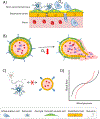Cerebral microvascular complications of type 2 diabetes: stroke, cognitive dysfunction, and depression
- PMID: 32135131
- PMCID: PMC11044807
- DOI: 10.1016/S2213-8587(19)30405-X
Cerebral microvascular complications of type 2 diabetes: stroke, cognitive dysfunction, and depression
Abstract
Adults with type 2 diabetes are at an increased risk of developing certain brain or mental disorders, including stroke, dementia, and depression. Although these disorders are not usually considered classic microvascular complications of diabetes, evidence is growing that microvascular dysfunction is one of the key underlying mechanisms. Microvascular dysfunction is a widespread phenomenon in people with diabetes, including effects on the brain. Cerebral microvascular dysfunction is also apparent in adults with prediabetes, suggesting that cerebral microvascular disease processes start before the onset of diabetes. The microvasculature is involved in the regulation of many cerebral processes that when impaired predispose to lacunar and haemorrhagic stroke, cognitive dysfunction, and depression. Main drivers of diabetes-related cerebral microvascular dysfunction are hyperglycaemia, obesity and insulin resistance, and hypertension. Increasing amounts of data from observational studies suggest that diabetes-related microvascular dysfunction is associated with a higher risk of stroke, cognitive dysfunction, and depression. Cerebral outcomes in diabetes might be improved following treatments targeting the pathways through which diabetes damages the microcirculation. These treatments might include drugs that reduce dicarbonyl compounds, augment cerebral insulin signalling, or improve blood-brain barrier permeability and cerebral vasoreactivity.
Copyright © 2020 Elsevier Ltd. All rights reserved.
Figures


References
-
- Cheng G, Huang C, Deng H, Wang H. Diabetes as a risk factor for dementia and mild cognitive impairment: a meta-analysis of longitudinal studies. Intern Med J 2012; 42(5): 484–91. - PubMed
-
- Wang F, Wang S, Zong QQ, et al. Prevalence of comorbid major depressive disorder in Type 2 diabetes: a meta-analysis of comparative and epidemiological studies. Diabet Med 2019; 36(8): 961–9. - PubMed
Publication types
MeSH terms
Grants and funding
LinkOut - more resources
Full Text Sources
Medical

